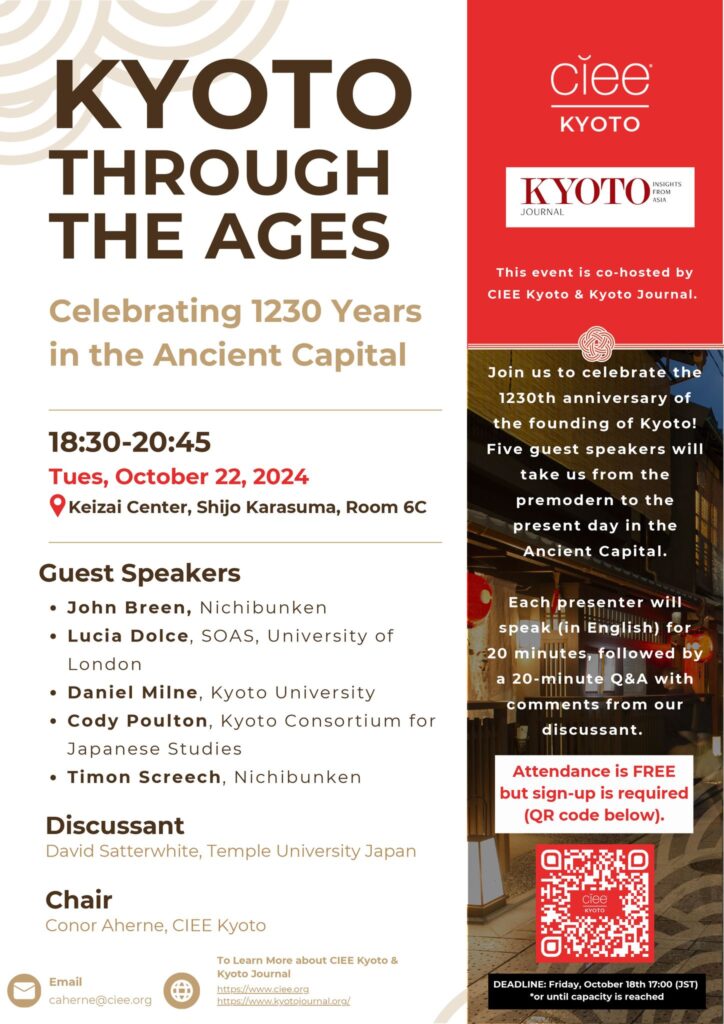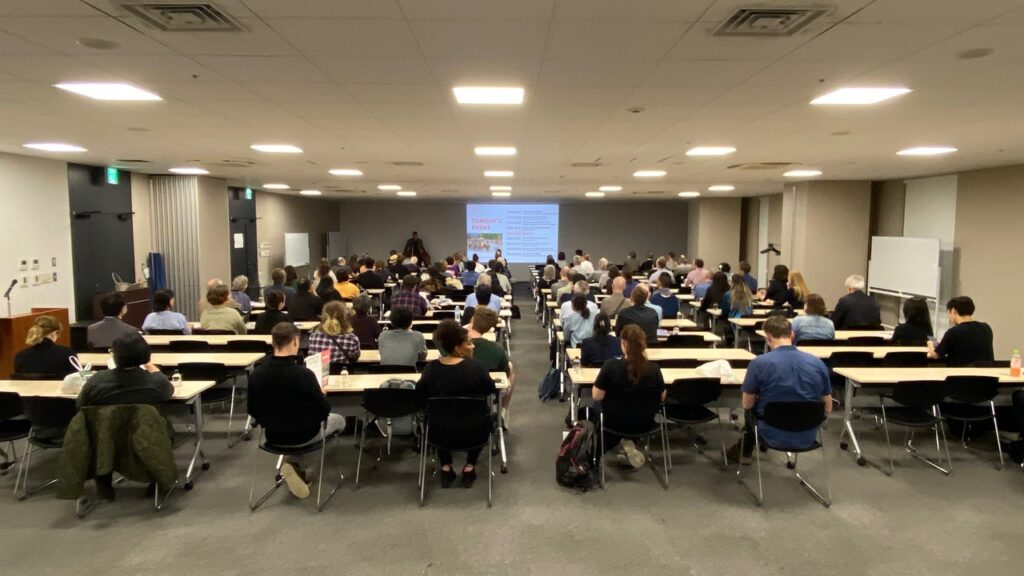An attentive audience of over 100 people gathered at the Keizai Center Building in central Kyoto for the first event in a series of events to be cohosted by CIEE (Council of International Exchange, www.ciee.org) and Kyoto Journal (kyotojournal.org), chaired by Conor Aherne of CIEE.

Five short talks were delivered by Kyoto-based scholars including Cody Poulton, a member of Writers in Kyoto. All five scholars are variously published both in academia and popular works, and each talk was interestingly illustrated by PowerPoint slides. Present were many members of WiK, friends and volunteer staff members of KJ and participants in CIEE’s study abroad program.
Since its inauguration 1,230 years ago, in AD 794, Kyoto has been central to Japan’s cultural heritage. Each speaker talked about their research specialization and, though they clearly could have talked much longer, gave interesting historical, cultural and social vignettes of this beloved city:
Religious Performance: Combinatory Liturgies in Medieval Kyoto
Lucia Dolce of Venice, London and the Netherlands, a professor at the School of Oriental and African Studies, University of London, spoke about the medieval period when temples and shrines had not yet been divided, and about various rituals that brought good fortune by venerating gods or appeased vengeful spirits and guarded against misfortune. She cited ceremonies that are still performed today, particularly associated with Enryakuji, Yasaka Shrine and the Gion Festival.
See Lucia Dolce’s page on the School of Oriental and African Studies website.
Zeami & Okuni: Kyoto and the Founders of Noh & Kabuki
Cody Poulton, formerly of the University of Victoria (B.C.), and now at the Kyoto Consortium of Japanese Studies—and a valued member of Writers in Kyoto—showed his considerable expertise in the performing arts of Kyoto, describing vividly the beginnings of Noh, and the emergence of Kabuki on the Kamo riverbed, a summertime venue for many different types of performance. He particularly spoke about the Japanese aesthetic of yugen 幽玄 (mystery, grace, awe, wordlessness) which is so much a part of the performing arts, especially Noh.
See more about Cody Poulton on the Writers in Kyoto site and in this podcast with Amy Chavez at Books on Asia.
Leisure Travel to Kyoto in the Early Edo Period
Timon Screech, formerly of the School of Oriental and African Studies, University of London, now at Nichibunken, Kyoto’s International Research Center for Japanese Studies, talked about the interest of Edo (Tokyo) people in the city of Kyoto, and the guidebooks, illustrations, etc., and even the building of facsimile buildings which fueled this interest during the Edo period, also touching on the riverside entertainment scene in Kyoto. At that time, foreigners (mostly Dutch merchants) were restricted to the port of Dejima in Kyushu, but once a year a delegation was allowed to stop by Kyoto on their way back from paying their respects to the Shogun in Edo, a custom which may have represented Kyoto inhabitants’ earliest experiences of Caucasian visitors.
Timon provided the lead article in KJ 107 (Fire & Kyoto).
Festivals and Pageants in the Making of Modern Kyoto
John Breen, also at Nichibunken, specializing in Japanese history, focused on the major contribution made to the modernization of Meiji-period Kyoto by courtier and statesman Iwakura Tomomi, including his role in the establishment of Heian Jingu, as a symbol of Kyoto’s imperial heritage, and the Jidai Matsuri, which commemorates the city’s many successive historical eras. Iwakura is best known for his role as plenipotentiary ambassador leading the Iwakura Mission, which spent nearly two years (1871-1873) in the U.S. and Europe and laid the foundation of many important Meiji period reforms.
John edited Kyoto’s Renaissance, comprehensively reviewed here.
See also, his profile on John Dougill’s Green Shinto site.
Occupation and Post-War Tourism In Kyoto
Daniel Milne is Senior Lecturer at Kyoto University’s Institute for Liberals Arts and Sciences (ILAS, focusing on “the modern history of tourism in Japan and Kyoto, and the political and cultural role the discourses and spaces of tourism have played in war, occupation, and reconciliation.” His talk brought closure to the night’s wide-ranging topics, revealing how Kyoto has since the mid-nineteenth century developed and evolved its reputation as Japan’s primary cultural attraction for domestic and overseas visitors.
Daniel is a member of the Modern Kyoto Research team, which maintains an informative online resource at www.modernkyotoresearch.org. In 2019, Daniel co-edited “War, Tourism, and Modern Japan,” a special issue of Japan Review.
David Satterwhite of Temple University briefly summed up the presentations; unfortunately time was too tight to allow the intended Q&A session. Nevertheless, the event was a valuable opportunity for attendees to learn more about various fields of interest in Kyoto’s rich, unique and world-renowned heritage.
The next event in this series will be held in December. Details will be announced in November.

